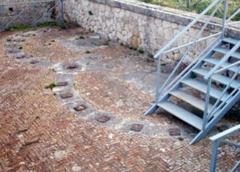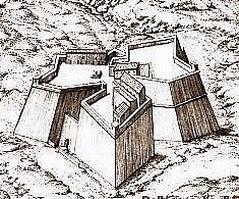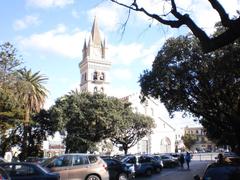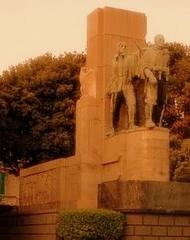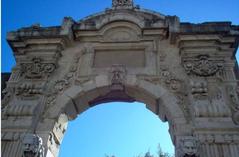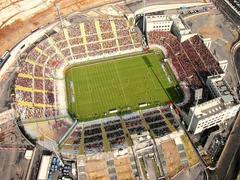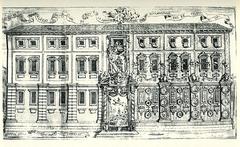
Astronomical Clock Messina: Visiting Hours, Tickets, and Historical Significance
Date: 03/07/2025
Introduction
Nestled in the vibrant heart of Sicily, the Astronomical Clock of Messina is a remarkable blend of art, science, and cultural heritage. Housed in the cathedral’s bell tower at Piazza del Duomo, this monumental clock is far more than a timekeeping device—it is a living chronicle of Messina’s resilience, history, and spiritual identity. Crafted by the renowned Ungerer Company of Strasbourg and inaugurated in 1933 following the devastation of the 1908 earthquake, the clock’s intricate dials, animated bronze figures, and mechanical spectacular at noon make it an essential stop for travelers interested in horology, history, and Sicilian culture. This guide offers comprehensive insights into visiting hours, ticketing, accessibility, special events, and nearby attractions to help you plan an unforgettable visit (Savoring Italy; Trip.com; Visit Sicily).
Table of Contents
- Overview and Historical Context
- Origins and Early History
- The 1908 Earthquake and Restoration
- The Modern Astronomical Clock: Features and Symbolism
- Architectural Design and Mechanical Engineering
- Visitor Information: Hours, Tickets, and Accessibility
- The Noon Spectacle: What to Expect
- Climbing the Bell Tower and Panoramic Views
- Practical Tips for Visitors
- Nearby Attractions and Itinerary Planning
- Cultural Significance and Local Customs
- Frequently Asked Questions (FAQ)
- Visuals, Media, and Further Resources
- Summary and Recommendations
- Sources
Overview and Historical Context
The Astronomical Clock of Messina, or “Orologio Astronomico del Duomo di Messina,” stands as one of Europe’s most impressive horological monuments. Originally installed in the 16th century, the clock has been intricately tied to the city’s fortunes—serving as a symbol of civic pride, scientific achievement, and spiritual devotion. Messina’s strategic location at the northeastern tip of Sicily has made it a crossroads of Mediterranean cultures, and the clock’s history mirrors the city’s own cycles of adversity and renewal (Savoring Italy).
Origins and Early History
The original astronomical clock was installed during the Renaissance, an era when such clocks symbolized advancements in science and the arts. These clocks were designed not only to keep time but to educate the public and celebrate religious themes and local legends. The Messina Cathedral itself was founded in the Norman period, and the clock housed in its bell tower became a focal point for both locals and travelers.
The 1908 Earthquake and Restoration
On December 28, 1908, Messina suffered one of Europe’s most catastrophic earthquakes, which, together with a subsequent tsunami, destroyed much of the city, including the cathedral and its original clock. The disaster claimed around 80,000 lives and left the city in ruins. The loss of the original clock was deeply felt, but Messina’s residents undertook a determined rebuilding effort, culminating in the restoration of the cathedral and the commissioning of a new astronomical clock (Savoring Italy).
The Modern Astronomical Clock: Features and Symbolism
Commissioned in 1930 and inaugurated in 1933, the new clock was created by the Ungerer Company of Strasbourg. Today, it is one of the largest and most complex astronomical clocks in the world (Trip.com). Every day at noon, crowds gather to witness the 12-minute spectacle, featuring:
- The Roaring Lion: Symbolizes Messina’s strength.
- The Crowing Rooster: Marks vigilance and renewal.
- Processions and Tableaux: Scenes from the life of the Virgin Mary and city legends, including Messina’s patron saints and legendary heroines Dina and Clarenza.
- Astronomical Dials: Display time, lunar phases, planetary positions, zodiac signs, and the liturgical calendar.
This blend of science, faith, and local tradition makes the clock an unparalleled attraction (Savoring Italy).
Architectural Design and Mechanical Engineering
Structure and Layout
The clock tower stands at 60 meters (197 feet), with a square base of 9.6 meters per side (Messinarte; Discover Messina). Its facades feature vertically arranged dials and animated tableaux, with the south side especially notable for its perpetual calendar and planetarium (The World of Sicily).
Materials and Artistic Elements
The tower uses local stone and features Norman, Gothic, and modern influences. The animated figures are cast in gilded bronze, while marble is used for static elements like the angel on the calendar (Messinarte).
Mechanical Features
- Engineered by Frédéric Klinghammer and directed by Théodore Ungerer, the internal mechanism is powered by counterweights and a sophisticated system of gears and levers (Wikipedia; Italia.it).
- Animated Figures: The lion, rooster, Madonna della Lettera, and more perform during the noon show, accompanied by Schubert’s “Ave Maria” (The World of Sicily).
- Tableaux and Carousels: Scenes change with the liturgical calendar, and a “Stages of Life” carousel marks the passage of time (Italia.it).
- Dials: The perpetual calendar, planetarium, and lunar sphere are all mechanically linked for precision (Italy Notes).
Visitor Information: Hours, Tickets, and Accessibility
Visiting Hours and Tickets
- Show Time: The animated spectacle occurs daily at 12:00 noon.
- Opening Hours: The bell tower is generally open from 9:00 to 13:00 and 16:00 to 19:00, but these may vary seasonally (Trip.com).
- Tickets: Entry to the bell tower typically costs €4–6 per person. Tickets can be purchased on-site (Trip.com).
Accessibility
- The bell tower is not wheelchair accessible due to its spiral ramp and 236-step climb. The piazza and cathedral are accessible for those with mobility challenges.
- For panoramic city views, visitors can climb to the terrace at the top of the tower.
The Noon Spectacle: What to Expect
At noon each day, the clock’s mechanisms animate a series of bronze figures:
- The Lion roars, waves a flag, and raises its paw.
- The Rooster crows and flaps its wings.
- Processions: Ambassadors, saints, and legendary Messina heroines appear in a moving tableau.
- Carousels: Days of the week are depicted by planetary deities in chariots, and panels reveal biblical and historical events.
The spectacle is enhanced by the chimes of the bells and the melody of Schubert’s “Ave Maria” (Great Sicily).
Climbing the Bell Tower and Panoramic Views
Visitors can ascend the bell tower’s spiral ramp to view the clock’s mechanisms and enjoy breathtaking vistas of Messina, the Strait, Calabria, and—on clear days—Mount Etna. The climb is manageable for most but is not recommended for those with limited mobility.
Practical Tips for Visitors
- Arrive Early: To secure a good viewpoint for the noon show, arrive at Piazza Duomo by 10:30 AM.
- Wear Comfortable Shoes: The climb and city streets are best navigated with sturdy footwear.
- Bring Sun Protection: During summer, hats and sunscreen are advised.
- Sample Local Food: Try Messina’s arancini, granita, piparelli biscuits, and regional wines at local pastry shops and cafés.
- Photography: Photography is allowed; the best vantage points are in the piazza and atop the bell tower.
- Facilities: Restrooms are available near Piazza Duomo; tourist information is located at the port.
Nearby Attractions and Itinerary Planning
- Messina Cathedral (Duomo di Messina): Adjacent to the clock tower, renowned for its mosaics and architecture.
- Fountain of Orion: Renaissance fountain in Piazza Duomo, a masterpiece by Giovanni Angelo Montorsoli.
- Regional Museum of Messina: Features important works from Sicily’s artistic heritage.
- Walking Tours: Explore Piazza Antonello, Via della Zecca, Teatro Vittorio Emanuele II, and local markets.
For day-trippers, plan to visit the major sites in the morning, witness the noon show, and enjoy Messina’s culinary scene in the afternoon.
Cultural Significance and Local Customs
The Astronomical Clock is integral to Messina’s identity, especially during the Festa della Madonna della Lettera on June 3rd, when special processions and events are held. The clock’s daily performance is a cherished ritual for locals and visitors alike.
During the noon spectacle, maintain a respectful silence and avoid eating or drinking in the piazza. Join locals in nearby cafés after the show to experience Messina’s convivial atmosphere.
Frequently Asked Questions (FAQ)
Q: What are the visiting hours for the Astronomical Clock of Messina?
A: The bell tower is generally open from 9:00 to 13:00 and 16:00 to 19:00. The animated show takes place daily at 12:00 noon.
Q: How much do tickets cost?
A: Entry to the bell tower is typically €4–6. Tickets can be purchased on-site.
Q: Is the bell tower accessible for people with limited mobility?
A: The bell tower is not wheelchair accessible due to the spiral ramp and stairs.
Q: Are guided tours available?
A: Yes, guided tours can be arranged through local operators or the tourist office.
Q: Where can I find good spots to photograph the clock?
A: Piazza Duomo offers central views, and the terrace atop the bell tower provides panoramic shots.
Visuals, Media, and Further Resources
For a richer experience, explore high-quality images and videos of the clock’s animated features, panoramic city views, and interactive maps. Use descriptive alt text such as “Astronomical Clock of Messina noon show” and “Messina Cathedral bell tower view.” Virtual tours and detailed itineraries are often available through Messina’s tourism platforms.
Summary and Recommendations
The Astronomical Clock of Messina is a unique fusion of art, science, and local legend, symbolizing the city’s endurance and cultural depth. Its daily noon performance is a must-see, and the surrounding historical sites offer a rewarding itinerary for any visitor. Arrive early, purchase tickets on-site, and be prepared for an engaging journey through Sicilian history and tradition.
For up-to-date information, guided tours, and visitor tips, consult official resources and consider downloading the Audiala app to enhance your experience (Savoring Italy; Trip.com; Visit Sicily; Great Sicily).







